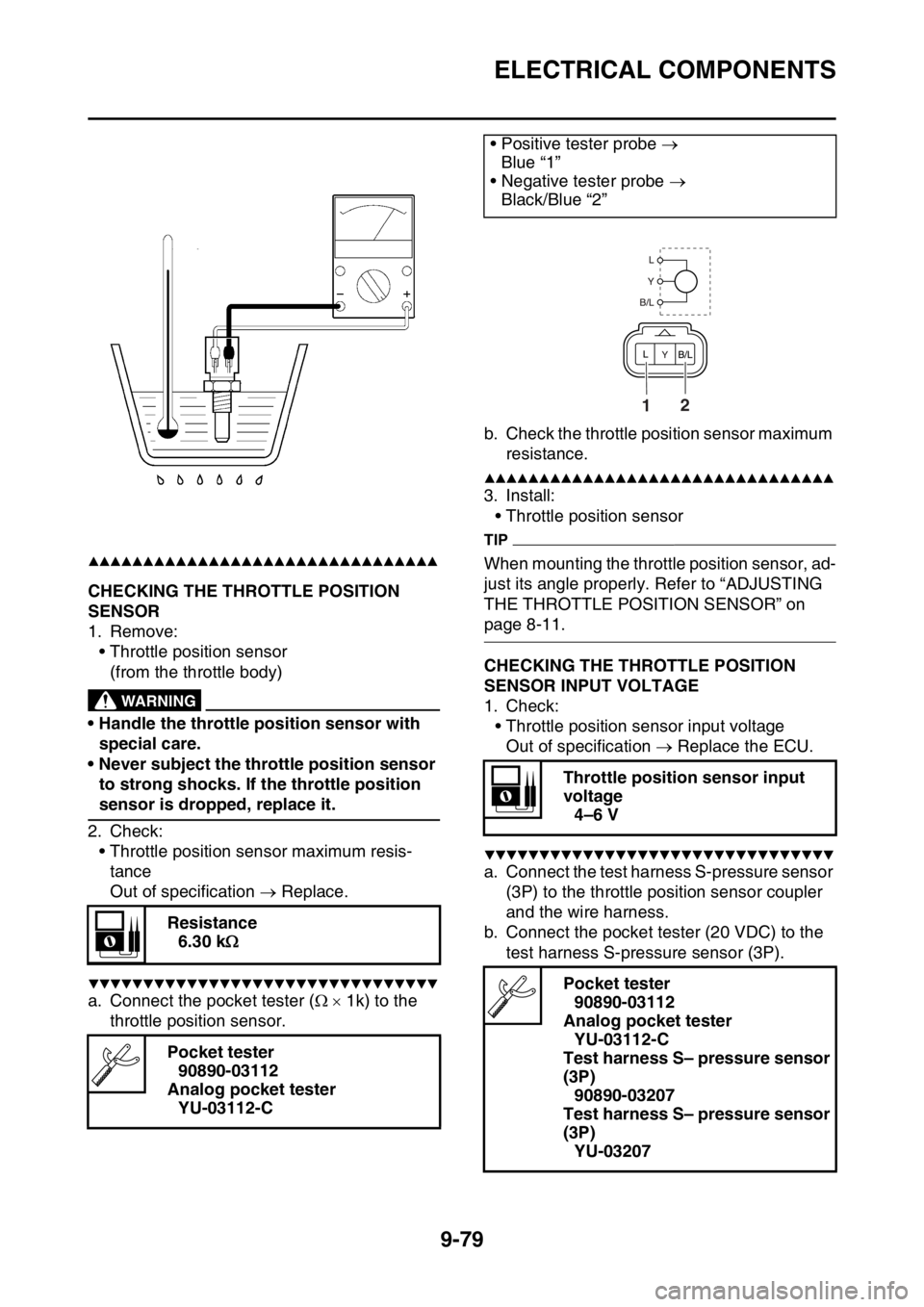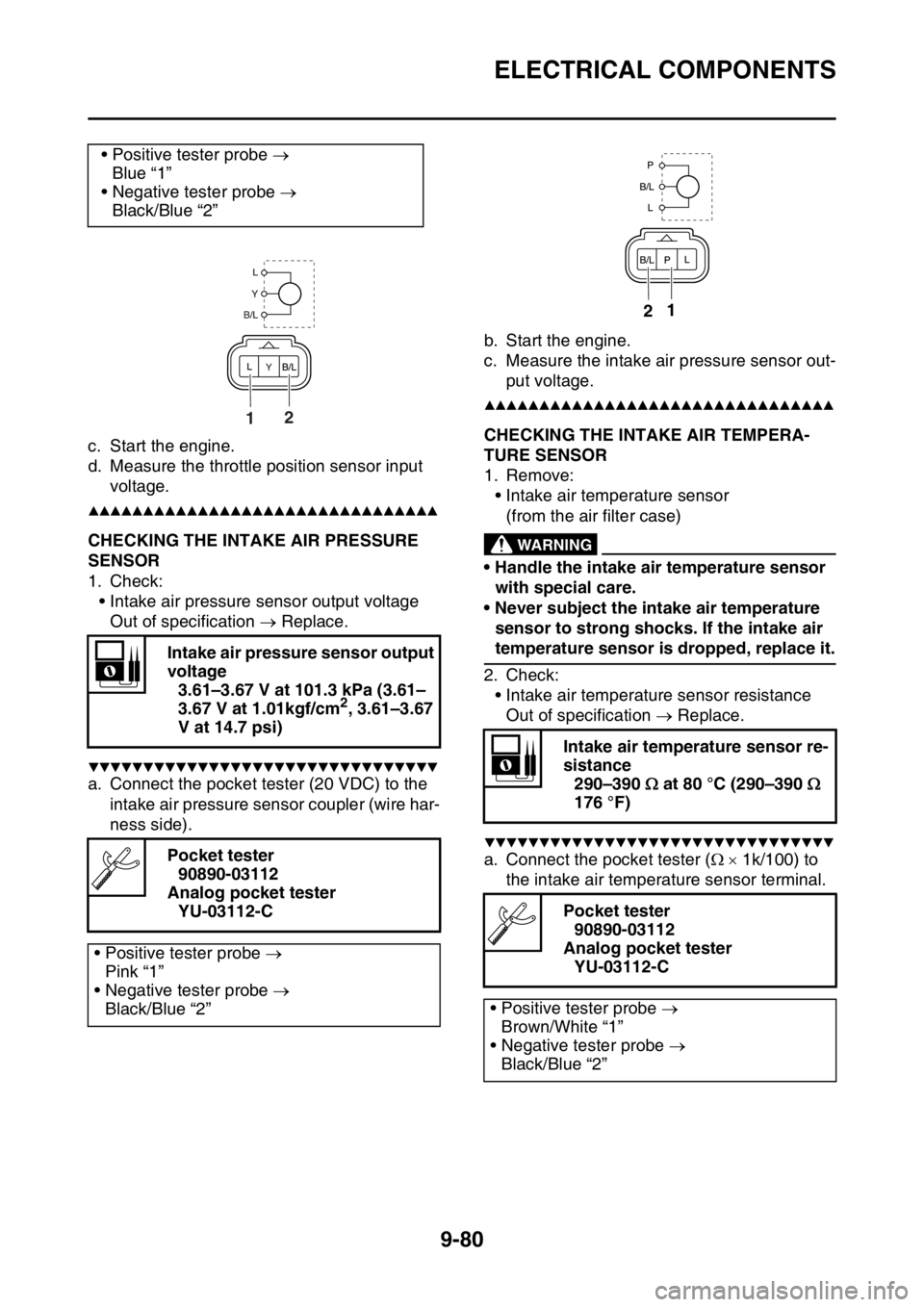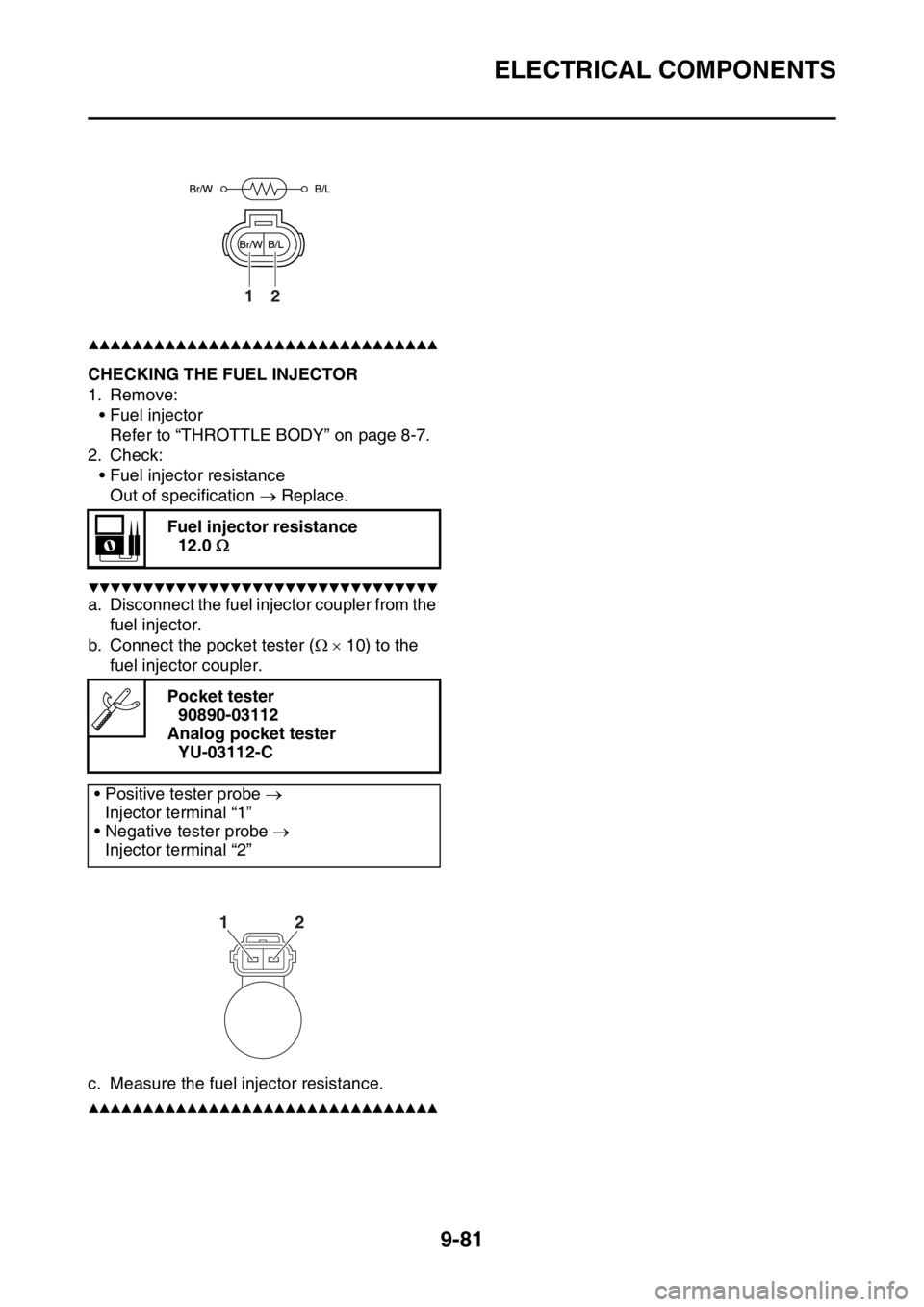YAMAHA WR 250F 2016 Owners Manual
Manufacturer: YAMAHA, Model Year: 2016, Model line: WR 250F, Model: YAMAHA WR 250F 2016Pages: 428, PDF Size: 14.13 MB
Page 411 of 428

ELECTRICAL COMPONENTS
9-79
▲▲▲▲▲▲▲▲▲▲▲▲▲▲▲▲▲▲▲▲▲▲▲▲▲▲▲▲▲▲▲▲
EAS2GB7400CHECKING THE THROTTLE POSITION
SENSOR
1. Remove:
• Throttle position sensor
(from the throttle body)
EWA
WARNING
• Handle the throttle position sensor with
special care.
• Never subject the throttle position sensor
to strong shocks. If the throttle position
sensor is dropped, replace it.
2. Check:
• Throttle position sensor maximum resis-
tance
Out of specification Replace.
▼▼▼▼▼▼▼▼▼▼▼▼▼▼▼▼▼▼▼▼▼▼▼▼▼▼▼▼▼▼▼▼
a. Connect the pocket tester ( 1k) to the
throttle position sensor.b. Check the throttle position sensor maximum
resistance.
▲▲▲▲▲▲▲▲▲▲▲▲▲▲▲▲▲▲▲▲▲▲▲▲▲▲▲▲▲▲▲▲
3. Install:
• Throttle position sensor
TIP
When mounting the throttle position sensor, ad-
just its angle properly. Refer to “ADJUSTING
THE THROTTLE POSITION SENSOR” on
page 8-11.
EAS2GB7401CHECKING THE THROTTLE POSITION
SENSOR INPUT VOLTAGE
1. Check:
• Throttle position sensor input voltage
Out of specification Replace the ECU.
▼▼▼▼▼▼▼▼▼▼▼▼▼▼▼▼▼▼▼▼▼▼▼▼▼▼▼▼▼▼▼▼
a. Connect the test harness S-pressure sensor
(3P) to the throttle position sensor coupler
and the wire harness.
b. Connect the pocket tester (20 VDC) to the
test harness S-pressure sensor (3P). Resistance
6.30 k
Pocket tester
90890-03112
Analog pocket tester
YU-03112-C
• Positive tester probe
Blue “1”
• Negative tester probe
Black/Blue “2”
Throttle position sensor input
voltage
4–6 V
Pocket tester
90890-03112
Analog pocket tester
YU-03112-C
Test harness S– pressure sensor
(3P)
90890-03207
Test harness S– pressure sensor
(3P)
YU-03207
21
Page 412 of 428

ELECTRICAL COMPONENTS
9-80
c. Start the engine.
d. Measure the throttle position sensor input
voltage.
▲▲▲▲▲▲▲▲▲▲▲▲▲▲▲▲▲▲▲▲▲▲▲▲▲▲▲▲▲▲▲▲
EAS2GB7402CHECKING THE INTAKE AIR PRESSURE
SENSOR
1. Check:
• Intake air pressure sensor output voltage
Out of specification Replace.
▼▼▼▼▼▼▼▼▼▼▼▼▼▼▼▼▼▼▼▼▼▼▼▼▼▼▼▼▼▼▼▼
a. Connect the pocket tester (20 VDC) to the
intake air pressure sensor coupler (wire har-
ness side).b. Start the engine.
c. Measure the intake air pressure sensor out-
put voltage.
▲▲▲▲▲▲▲▲▲▲▲▲▲▲▲▲▲▲▲▲▲▲▲▲▲▲▲▲▲▲▲▲
EAS2GB7403CHECKING THE INTAKE AIR TEMPERA-
TURE SENSOR
1. Remove:
• Intake air temperature sensor
(from the air filter case)
EWA
WARNING
• Handle the intake air temperature sensor
with special care.
• Never subject the intake air temperature
sensor to strong shocks. If the intake air
temperature sensor is dropped, replace it.
2. Check:
• Intake air temperature sensor resistance
Out of specification Replace.
▼▼▼▼▼▼▼▼▼▼▼▼▼▼▼▼▼▼▼▼▼▼▼▼▼▼▼▼▼▼▼▼
a. Connect the pocket tester ( 1k/100) to
the intake air temperature sensor terminal. • Positive tester probe
Blue “1”
• Negative tester probe
Black/Blue “2”
Intake air pressure sensor output
voltage
3.61–3.67 V at 101.3 kPa (3.61–
3.67 V at 1.01kgf/cm
2, 3.61–3.67
V at 14.7 psi)
Pocket tester
90890-03112
Analog pocket tester
YU-03112-C
• Positive tester probe
Pink “1”
• Negative tester probe
Black/Blue “2”
21
Intake air temperature sensor re-
sistance
290–390 at 80 °C (290–390
176 °F)
Pocket tester
90890-03112
Analog pocket tester
YU-03112-C
• Positive tester probe
Brown/White “1”
• Negative tester probe
Black/Blue “2”
12
Page 413 of 428

ELECTRICAL COMPONENTS
9-81
▲▲▲▲▲▲▲▲▲▲▲▲▲▲▲▲▲▲▲▲▲▲▲▲▲▲▲▲▲▲▲▲
EAS2GB7404CHECKING THE FUEL INJECTOR
1. Remove:
• Fuel injector
Refer to “THROTTLE BODY” on page 8-7.
2. Check:
• Fuel injector resistance
Out of specification Replace.
▼▼▼▼▼▼▼▼▼▼▼▼▼▼▼▼▼▼▼▼▼▼▼▼▼▼▼▼▼▼▼▼
a. Disconnect the fuel injector coupler from the
fuel injector.
b. Connect the pocket tester ( 10) to the
fuel injector coupler.
c. Measure the fuel injector resistance.
▲▲▲▲▲▲▲▲▲▲▲▲▲▲▲▲▲▲▲▲▲▲▲▲▲▲▲▲▲▲▲▲
Fuel injector resistance
12.0
Pocket tester
90890-03112
Analog pocket tester
YU-03112-C
• Positive tester probe
Injector terminal “1”
• Negative tester probe
Injector terminal “2”
12
12
Page 414 of 428

ELECTRICAL COMPONENTS
9-82
Page 415 of 428

10
TROUBLESHOOTING
TROUBLESHOOTING.................................................................................... 10-1
GENERAL INFORMATION ...................................................................... 10-1
STARTING FAILURES ............................................................................. 10-1
INCORRECT ENGINE IDLING SPEED ................................................... 10-1
POOR MEDIUM-AND-HIGH-SPEED PERFORMANCE .......................... 10-2
SHIFTING IS DIFFICULT ......................................................................... 10-2
SHIFT PEDAL DOES NOT MOVE ........................................................... 10-2
JUMPS OUT OF GEAR............................................................................ 10-2
CLUTCH SLIPS ........................................................................................ 10-2
CLUTCH DRAGS ..................................................................................... 10-2
OVERHEATING ....................................................................................... 10-2
OVERCOOLING ....................................................................................... 10-3
POOR BRAKING PERFORMANCE ......................................................... 10-3
FRONT FORK OIL LEAKING ................................................................... 10-3
FAULTY FRONT FORK LEGS ................................................................. 10-3
UNSTABLE HANDLING ........................................................................... 10-3
HEADLIGHT DOES NOT COME ON ....................................................... 10-4
HEADLIGHT BULB BURNT OUT............................................................. 10-4
TAILLIGHT DOES NOT COME ON ......................................................... 10-4
LIST OF SELF-DIAGNOSTIC AND FAIL-SAFE ACTIONS........................... 10-5
Page 416 of 428

TROUBLESHOOTING
10-1
EAS2GB7405
TROUBLESHOOTING
EAS2GB7406GENERAL INFORMATION
TIP
The following guide for troubleshooting does
not cover all the possible causes of trouble. It
should be helpful, however, as a guide to basic
troubleshooting. Refer to the relative procedure
in this manual for checks, adjustments, and re-
placement of parts.
EAS2GB7407STARTING FAILURES
Engine
1. Cylinder and cylinder head
• Loose spark plug
• Loose cylinder head or cylinder
• Damaged cylinder head gasket
• Damaged cylinder gasket
• Worn or damaged cylinder
• Incorrect valve clearance
• Improperly sealed valve
• Incorrect valve-to-valve-seat contact
• Incorrect valve timing
• Faulty valve spring
• Seized valve
2. Piston and piston ring(s)
• Improperly installed piston ring
• Damaged, worn or fatigued piston ring
• Seized piston ring
• Seized or damaged piston
3. Air filter
• Improperly installed air filter
• Clogged air filter element
4. Crankcase and crankshaft
• Improperly assembled crankcase
• Seized crankshaft
Fuel system
1. Fuel tank
• Empty fuel tank
• Clogged fuel tank breather hose
• Deteriorated or contaminated fuel
• Clogged or damaged fuel hose
2. Fuel pump
• Faulty fuel pump
3. Throttle body
• Deteriorated or contaminated fuel
• Sucked-in air
Electrical system
1. Spark plug
• Incorrect spark plug gap• Incorrect spark plug heat range
• Fouled spark plug
• Worn or damaged electrode
• Worn or damaged insulator
2. Ignition coil
• Cracked or broken ignition coil body
• Broken or shorted primary or secondary
coils
3. Ignition system
• Faulty ECU
• Faulty crankshaft position sensor
• Broken generator rotor woodruff key
4. Switches and wiring
• Faulty ECU
• Faulty engine stop switch
• Broken or shorted wiring
• Faulty neutral switch
• Improperly grounded circuit
• Loose connections
EAS2GB7408INCORRECT ENGINE IDLING SPEED
Engine
1. Cylinder and cylinder head
• Incorrect valve clearance
• Damaged valve train components
2. Air filter
• Clogged air filter element
Fuel system
1. Throttle body
• Damaged or loose throttle body joint
• Improperly synchronized throttle bodies
• Improper throttle cable free play
• Flooded throttle body
Electrical system
1. Spark plug
• Incorrect spark plug gap
• Incorrect spark plug heat range
• Fouled spark plug
• Worn or damaged electrode
• Worn or damaged insulator
• Faulty spark plug cap
2. Ignition coil
• Broken or shorted primary or secondary
coils
• Cracked or broken ignition coil
3. Ignition system
• Faulty ECU
• Faulty crankshaft position sensor
• Broken generator rotor woodruff key
Page 417 of 428

TROUBLESHOOTING
10-2
EAS2GB7409POOR MEDIUM-AND-HIGH-SPEED PER-
FORMANCE
Refer to “STARTING FAILURES” on page 10-
1.
Engine
1. Air filter
• Clogged air filter element
Fuel system
1. Fuel pump
• Faulty fuel pump
2. Throttle body
• Defective throttle body
3. ECU
• Faulty ECU
EAS2GB7410SHIFTING IS DIFFICULT
Refer to “CLUTCH” on page 6-40.
EAS2GB7411SHIFT PEDAL DOES NOT MOVE
Engine
1. Shift shaft
• Bent shift shaft
2. Shift drum and shift forks
• Foreign object in a shift drum groove
• Seized shift fork
• Bent shift fork guide bar
3. Transmission
• Seized transmission gear
• Foreign object between transmission gears
• Improperly assembled transmission
EAS2GB7412JUMPS OUT OF GEAR
Engine
1. Shift shaft
• Incorrect shift pedal position
• Improperly returned stopper lever
2. Shift forks
• Worn shift fork
3. Shift drum
• Incorrect axial play
• Worn shift drum groove
4. Transmission
• Worn gear dog
EAS2GB7413CLUTCH SLIPS
Engine
1. Clutch
• Improperly assembled clutch
• Loose or fatigued clutch spring
• Worn friction plate
• Worn clutch plate
2. Engine oil
• Incorrect oil level
• Incorrect oil viscosity (low)
• Deteriorated oil
EAS2GB7414CLUTCH DRAGS
Engine
1. Clutch
• Unevenly tensioned clutch springs
• Warped pressure plate
• Bent clutch plate
• Swollen friction plate
• Bent clutch push rod
• Damaged clutch boss
• Burnt primary driven gear bushing
2. Engine oil
• Incorrect oil level
• Incorrect oil viscosity (high)
• Deteriorated oil
EAS2GB7415OVERHEATING
Engine
1. Cylinder head and piston
• Heavy carbon buildup
• Clogged coolant passages
2. Engine oil
• Incorrect oil level
• Incorrect oil viscosity
• Inferior oil quality
Cooling system
1. Coolant
• Low coolant level
2. Radiator
• Damaged or leaking radiator
• Faulty radiator cap
• Bent or damaged radiator fin
3. Water pump
• Damaged or faulty water pump
• Damaged hose
• Improperly connected hose
• Damaged pipe
• Improperly connected pipe
Page 418 of 428

TROUBLESHOOTING
10-3
Fuel system
1. Throttle body
• Damaged or loose throttle body joint
2. Air filter
• Clogged air filter element
Chassis
1. Brake(s)
• Dragging brake
Electrical system
1. Spark plug
• Incorrect spark plug gap
• Incorrect spark plug heat range
2. Ignition system
• Faulty ECU
• Faulty coolant temperature sensor
EAS2GB7416OVERCOOLING
Cooling system
1. Coolant temperature sensor
• Faulty coolant temperature sensor
EAS2GB7417POOR BRAKING PERFORMANCE
Chassis
1. Brake(s)
• Worn brake pad
• Worn brake disc
• Air in hydraulic brake system
• Leaking brake fluid
• Defective master cylinder kit
• Faulty brake caliper kit
• Faulty brake caliper seal
• Loose union bolt
• Damaged brake hose
• Oil or grease on the brake disc
• Oil or grease on the brake pad
• Incorrect brake fluid level
EAS2GB7418FRONT FORK OIL LEAKING
Chassis
1. Front fork
• Bent, damaged, or rusty inner tube
• Cracked or damaged outer tube
• Improperly installed oil seal
• Damaged oil seal lip
• Incorrect oil level (high)
• Loose damper rod assembly bolt
• Damaged damper rod assembly bolt copper
washer
• Cracked or damaged cap bolt O-ring
EAS2GB7419FAULTY FRONT FORK LEGS
Chassis
1. Front fork
• Bent or damaged inner tube
• Bent or damaged outer tube
• Broken fork spring
• Bent or damaged damper rod
• Incorrect oil viscosity
• Incorrect oil level
EAS2GB7420UNSTABLE HANDLING
Chassis
1. Handlebar
• Bent or improperly installed handlebar
2. Steering head components
• Improperly installed upper bracket
• Improperly installed lower bracket
(improperly tightened ring nut)
• Bent steering stem
• Damaged ball bearing or bearing race
3. Front fork leg (s)
• Uneven oil levels (both front fork legs)
• Unevenly tensioned fork spring (both front
fork legs)
• Broken fork spring
• Bent or damaged inner tube
• Bent or damaged outer tube
4. Swingarm
• Worn bearing or bushing
• Bent or damaged swingarm
5. Rear shock absorber assembly (-ies)
• Faulty rear shock absorber spring
• Leaking oil or gas
6. Tire (s)
• Uneven tire pressures (front and rear)
• Incorrect tire pressure
• Uneven tire wear
7. Wheel (s)
• Incorrect wheel balance
• Broken or loose spoke
• Damaged wheel bearing
• Bent or loose wheel axle
• Excessive wheel runout
8. Frame
• Bent frame
• Damaged steering head pipe
• Improperly installed bearing race
Page 419 of 428

TROUBLESHOOTING
10-4
EAS2GB7421HEADLIGHT DOES NOT COME ON
Electrical system
1. Headlight
• Fuse open circuit
• Wrong headlight bulb
• Too many electrical accessories
• Hard charging
• Incorrect connection
• Improperly grounded circuit
• Poor contacts (start switch)
• Burnt-out headlight bulb
EAS2GB7422HEADLIGHT BULB BURNT OUT
Electrical system
1. Headlight
• Wrong headlight bulb
• Faulty battery
• Faulty rectifier/regulator
• Improperly grounded circuit
• Faulty start switch
• Headlight bulb life expired
EAS2GB7423TAILLIGHT DOES NOT COME ON
Electrical system
1. Taillight
• Wrong taillight LED
• Too many electrical accessories
• Incorrect connection
• Faulty battery
Page 420 of 428

LIST OF SELF-DIAGNOSTIC AND FAIL-SAFE ACTIONS
10-5
EAS2GB7424
LIST OF SELF-DIAGNOSTIC AND FAIL-SAFE ACTIONS
LIST OF DIAGNOSTIC CODES
COMMUNICATION ERROR WITH YAMAHA DIAGNOSTIC TOOLFault
codeItem Page
12 Crankshaft position sensor: no normal signals are received from the
crankshaft position sensor.9-35
13 Intake air pressure sensor: open or short circuit detected. 9-37
14 Intake air pressure sensor: hose system malfunction (clogged or de-
tached hose)9-38
15 Throttle position sensor: open or short circuit detected. 9-39
16 Throttle position sensor: stuck throttle position sensor is detected. 9-41
21 Coolant temperature sensor: open or short circuit detected. 9-42
22 Intake air temperature sensor: open or short circuit detected. 9-43
30 Latch up detected. 9-44
33 Ignition coil: open or short circuit detected in the primary lead of the
ignition coil.9-45
39 Injector: open or short circuit detected. 9-47
41 Lean angle sensor: open or short circuit detected. 9-48
43 Fuel system voltage: incorrect voltage supplied to the fuel injector and
fuel pump.9-49
44 EEPROM fault code number: an error is detected while reading or
writing on EEPROM.9-50
46 Charging voltage is abnormal. 9-51
50 Faulty ECU memory. (When this malfunction is detected in the ECU,
the fault code number might not appear on the meter.)9-52
Fault
codeItem Page
Waiting
for con-
nectionNo communication signal is received from the ECU.
9-52
Er-2 Signals from the ECU cannot be received within the specified period
of time.9-53
Er-3 Data from the ECU cannot be received correctly. 9-54
Er-4 Registered data cannot be received from the Yamaha diagnostic tool. 9-55